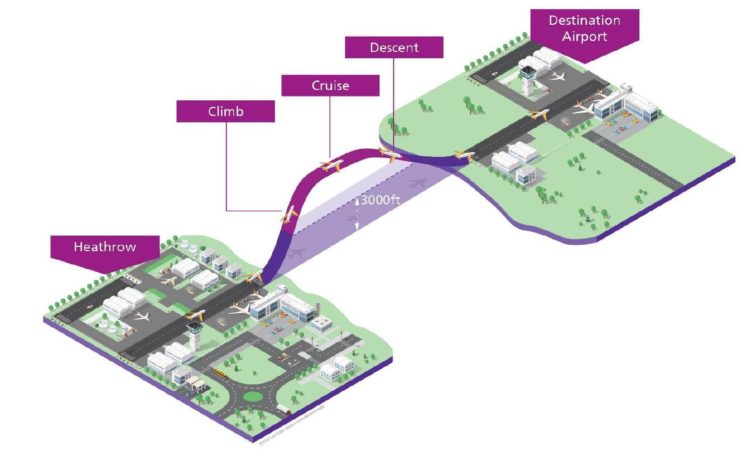The effects upon Climate Change that Heathrow expansion might cause are dealt with in PEIR Chapter 9 (click HERE for the document ). We say that Heathrow expansion is not possible within the greenhouse gas limits set down by either the Paris treaty or our own domestic legislation. Indeed, Heathrow airport may need to contract if we are going to contain warming to 1.5 degrees above pre-industrial levels or attain net zero emissions by 2050. Our views on Climate Change and Heathrow expansion are:
- The assessment in the PEIR Chapter 9 only relates to carbon. It does not relate to any other greenhouse gases. The ANPS states that “The applicant should quantify the greenhouse gas impacts before and after mitigation to show the impacts of the proposed mitigation”. This has not been done, even only because of the lack of consideration of other greenhouse gases apart from carbon. This is particularly important here, as the targets are likely to be exceeded.
- Even the DfT thinks that the other Greenhouse gases (GHGs) do “potentially have a radiative forcing effect (contribute to climate change) if emitted at altitude”. Yet, no assessment has been made, notwithstanding that Parliament has declared that we are in a state of climate change emergency. In support of its stance in this consultation, Heathrow states that it has followed advice from the Committee on Climate Change (“CCC”) given in 2017. That advice is out of date, and the current advice is contained in the CCC Net Zero Report of May 2019. That report acknowledges that at present the non CO2 Greenhouse Gases are not addressed explicitly but states that “The trade-off between reductions in non-CO2 effects and possible increases in CO2 emissions is currently not clear, but efforts should be made to identify these options and to implement them where possible”. Further advice from the CCC specifically on aviation is due by the end of December 2019. It is nonsensical to make plans for a project such as this without the advice of the CCC and without the inclusion of non-CO2 greenhouse gases in the light of the climate change emergency. Do we honestly think that Heathrow are meekly going to withdraw, if the scheme is non-complaint with climate change targets, after spending £17.6 billion on a new runway?
- The projected CO2 emissions, stated in Chapter 9 PEIR, for departing Heathrow planes are 20 MtCO2 by 2050, having peaked at over 25 MtCO2 per year in prior years (see their graph below).
 Current Total Air Traffic Movements (ATMs) throughout the year are 2,500,000 approx. Heathrow ATMs per year (now) are 480,000. Therefore, Heathrow’s proportion of ATMs of the whole is 19.05%.
Current Total Air Traffic Movements (ATMs) throughout the year are 2,500,000 approx. Heathrow ATMs per year (now) are 480,000. Therefore, Heathrow’s proportion of ATMs of the whole is 19.05%. - The target of CO2 limitation has been for only an 80% reduction of 1990 levels and not 100%. The Committee on Climate Change agreed that the target 80% reduction overall requires aviation CO2 emissions to be 37.5 MtCO2 by 2050 (which is 100% of the 2005 total). The proportion of Heathrow CO2 emissions to the target by 2050 was therefore 20MtCO2 ÷ 37.5MtCO2 = 53.33% of the total CO2 aviation emissions budget.
- 53.33% is considerably more than 19.05%. Therefore, Heathrow has very substantially more than its share of the CO2 budget – indeed it will have over half of the budget even though it currently has less than one quarter of the UK air traffic movements. Heathrow has more long-haul flights departing, so needs an extra part of the CO2 budget (Heathrow diagram below showing the departure journeys being within the calculation of aviation CO2 emissions), but no calculations have been given on what that proportion should be or how that proportion is justified in the light of ATMs of other airports.
 The amount of 53.33% of the total for Heathrow appears grossly excessive. Certainly, people are entitled to the information justifying this inequality and justification of the level of emissions. Entitlement is granted by the Aarhus Convention. We do know from the report of the Department for Transport entitled “Beyond the Horizon” of June 2018 that predicted CO2 is likely to be 40.8 MtCO2 in 2050 having peaked at 43.4 MtCO2 in 2030. Thus, aviation, with Heathrow expansion, will fail even on an 80% reduction over 1990 values – never mind a 100% reduction. Any reduction from 40.8 MtCO2 in 2050 is highly speculative and the Government should not be gambling with climate change in this way.
The amount of 53.33% of the total for Heathrow appears grossly excessive. Certainly, people are entitled to the information justifying this inequality and justification of the level of emissions. Entitlement is granted by the Aarhus Convention. We do know from the report of the Department for Transport entitled “Beyond the Horizon” of June 2018 that predicted CO2 is likely to be 40.8 MtCO2 in 2050 having peaked at 43.4 MtCO2 in 2030. Thus, aviation, with Heathrow expansion, will fail even on an 80% reduction over 1990 values – never mind a 100% reduction. Any reduction from 40.8 MtCO2 in 2050 is highly speculative and the Government should not be gambling with climate change in this way. - The likely required reduction of aviation emissions as a result of net zero is considered by the CCC to be down to no more than 31MtCO2 by 2050 (CCC Net Zero report May 2019 at page 148). This includes all forecast savings such as technology improvements and synthetic fuels and will require further cuts to CO2 emissions in the aviation sector than are currently forecast. There will be some 9.8MtCO2 (40.8 – 31) that is unprovided for.
- CORSIA will not be an acceptable off-set. Firstly mitigation (apart from carbon trading) will yield nothing like the required off-set. Trading, by getting poor nations to sacrifice their growth so that Heathrow and others can expand, will not be acceptable in the long term. The CCC has specifically said that it should be banned and the Government (against the advice of the CCC) has stated that it will only be permitted temporarily.
- Off-setting by carbon capture, such as peat bogs and tree planting, needs to be available for industry and activities as a whole. It cannot be monopolised by just one industry such as aviation, which already enjoys more climate change and tax concessions than any other industry.
- Heathrow appears to claim that either it is not within the climate change targets at all or, in the alternative, it can effectively subcontract its obligations by the airlines paying others to off-set its emissions by purchasing off-sets.
- The first goes directly against what the CCC advises, so that aviation emissions must be within budgets and if specified reductions not made then other emitters must reduce by a compensating amount. The second is unsupervised and pays for the most vulnerable countries to reduce expansion of their economies.
- Heathrow itself clearly anticipates substantial climate change effects as set out in PIER Chapter 10. Preparations for increased flooding, storms, droughts and heat are provided for. Para 10.10.6 refers to anticipated increases in temperature of 3°C by 2080 and 4.1°C by 2099
- It is said that aviation accounts for only 2% of CO2 in the atmosphere. This is misleading though, since it is a global figure. The Committee on Climate Change’s factsheet of 2011 shows that the UK figure is 6%. By 2050, the proportion is expected to have grown to well in excess of 50% due to the inability of aviation to reduce its CO2 output.
- It is said by both Heathrow (e.g. in public consultations) and the Government (e.g. evidence of Chris Grayling to Transport Committee on the 17th July 2019), that we, the UK, cannot tackle aviation climate change emissions on our own since it is a global problem. It is said that if we curb aviation on our own, others will take up the demand and we will be left behind. That is not a valid argument. No nation should delay their obligations. We all need to abide by the agreed Paris Treaty obligations. Those signatory countries that do not comply will have to be subject to other sanctions such as trade sanctions of some sort. The aviation industry is not above the law and should obey the rules. There is a government acknowledged climate change emergency and the GHG emissions must be kept within check. Although international aviation itself is exempt, the effects of aviation are not. If excess emissions from international aviation cannot be absorbed by savings elsewhere, then those excess emissions should not be permitted.
- If Heathrow expansion, which is the equivalent of a new airport the size of Gatwick being annexed to it, is permitted, then an existing airport of similar size has to close. Compliance is just not possible without this. Neither Heathrow nor the Government have produced a shred of evidence that anything else is the case.
- It is irresponsible of Heathrow to put forward an expansion project like this as compliant within our climate change obligations, when firstly it so obviously will not be compliant, and secondly there is no explanation in the documents provided to justify likely compliance after the expansion of Heathrow.
- If expansion of Heathrow were allowed in the Development Consent Order, we would expect the decision to be challenged in Court by Judicial Review.

Excellent, fact based report that is easy to understand by the average non scientific member of the public.